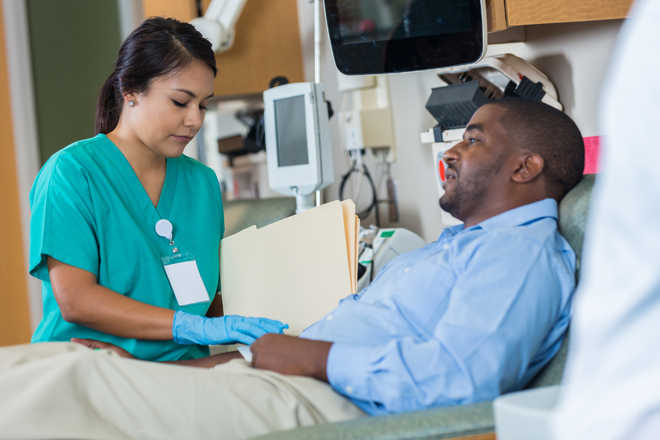
Tough to beat: The only treatment is lifelong repeated blood transfusions, while permanent cure is bone marrow transplant.
Dr JS Arora
Thalassaemia is a serious inherited blood disorder in which body cannot make enough haemoglobin; and whatever haemoglobin is created, it is defective. The normal life of red blood cells (RBCs) is 120 days. In thalassaemic patients, RBCs’ life is just 15-20 days. As speed of destruction is higher than the production, the new cells that form are defective, which leads to severe anaemia. Normally, anaemia can be treated with iron supplements, vitamins, proteins etc., but in thalassaemia as the defect is in manufacturing organ (bone marrow), these supplements do not help.
Cause and symptoms
Genetically an adult haemoglobin molecule is formed by symmetric pairing of two alpha and beta (ß) globins with iron molecule in the centre. In thalassaemia, synthesis of either alpha chains or ß chains is reduced. In ß thalassaemia, there is defective synthesis of ß chains and the manifestations are due to the excessive alpha chains. While in alpha thalassaemia, alpha chains are reduced and excess of ß chains cause reduced survival. In our country, ß thalassaemia is common and hence the term thalassaemia denotes ß thalassaemia.
At the time of birth, an affected child seems normal and healthy. From three months onwards the child starts showing signs and symptoms of severe anaemia like pallor, loss of appetite, lethargy. If treatment is not started at this time, facial bone becomes swollen, forehead and jaw is protruded, limb bone becomes weak, liver and spleen also get enlarged. In absence of diagnosis or treatment, death can happen within five years.
Treatment
As body cannot make adequate haemoglobin, the only treatment is lifelong repeated blood transfusions. In a normal person when RBCs break down after 120 days, these release iron and protein. The protein becomes part of plasma and iron is reutilised in formation of new cells but in thalassaemia major, the iron released from the breakdown of transfused RBCs becomes extra. There is no natural mechanism in body to excrete this extra iron. This extra iron gets deposited in vital organs and damages these organs. It affects growth and causes endocrine problems, liver and heart failure and ultimately untimely death. Medicines (iron chelating agents) have to be taken daily to expel out this extra iron from the body. Many patients have to take injections for eight to 12 hours every night throughout life. Repeated investigations become part of their life. Cost of therapy is approximately Rs 50,000 to Rs 2,00,000 per annum. Treatment of complications like splenomegaly (enlargement of spleen), endocrine, bone disease, Hepatitis B, Hepatitis C, HIV, liver and heart failure further escalates the cost.
Permanent cure lies in bone marrow transplant (BMT) but it’s feasible only if HLA-matched donor is available. Chance of getting HLA-matched donor is just 25 to 30 per cent. The cost of BMT is Rs 15, 00,000 to Rs 30, 00,000. Procedure is complicated and highly risky. A rate of 5 to 10 per cent mortality is likely even in ideal patients and at best centres.
Impact on patient’s and caretakers
The conventional treatment of thalassaemia major is life-long repeated blood transfusions to maintain haemoglobin level above 10gm/dl. During infancy and early childhood (1-5 years), the affected child requires on an average one unit of blood every month, between 5-10 years around two units of blood every month are needed and during 10-15 years, three units per month are required. When a patient grows to adulthood, two units every two weeks are needed for survival.
No family can afford to arrange this much volume of blood. Many times transfusion centres are far away from small cities or towns and the family has to travel 100-300 km to get blood transfusions. Many times patients develop reaction to transfusion which further increases their frequency of blood transfusions. Besides repeated hospital visits, time, energy and money spent on travel, these patients are at high risk of getting transfusion transmitted infections like Hepatitis B, Hepatitis C, HIV, etc. Because of paucity of blood, travel distance, cost involved and other family commitments, many patients frequently miss the transfusion schedule. This causes anaemia, which leads to growth retardation, repeated infections, delayed or missed puberty etc.
Repeated hospital visits and infections lead to irregular education and loss of income to the family. Most patients become unsuitable for employment.
At times, when patients come from small towns or rural areas, they can become victims of myths or unsafe treatments. Recently, an institute in Gujarat has claimed that goat blood enema reduces the requirement of blood transfusions in thalassaemia patients. There is no medical evidence or published data to support this claim. Thalassaemic patients should stick to only evidence-based treatment.
Prevention
At least 4.5 per cent of world population is thalassaemia carrier. In India average carrier rate is 4 per cent. It is more common in communities like Punjabis, Sindhis, Gujaratis and Bengalis. Thalassaemia carriers are normal and healthy and do not require any treatment but they can pass on this problem to their kids unknowingly. If both parents are thalassaemia carriers, then in each pregnancy there is 25 per cent chance of the infant having thalassaemia major, 50 per cent of chance new-born being a thalassaemia carrier and just 25 per cent chance of being normal. Thalassaemia is a preventable disorder. Before marriage or planning children, every couple should get checked for being a thalassaemia carrier. If both are not thalassaemia carriers or only one of them is a carrier then their child will never be affected with thalassaemia major disease. However, if both parents are carriers then at ten weeks’ of pregnancy foetus can be tested for thalassaemia status. If the foetus is affected then it can be legally aborted.
—The writer is a thalasssaemialogist and general secretary, National Thalassemia Welfare Society



























